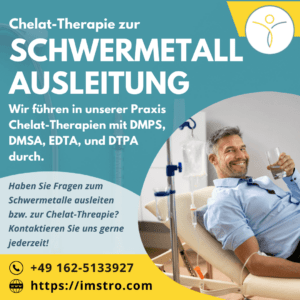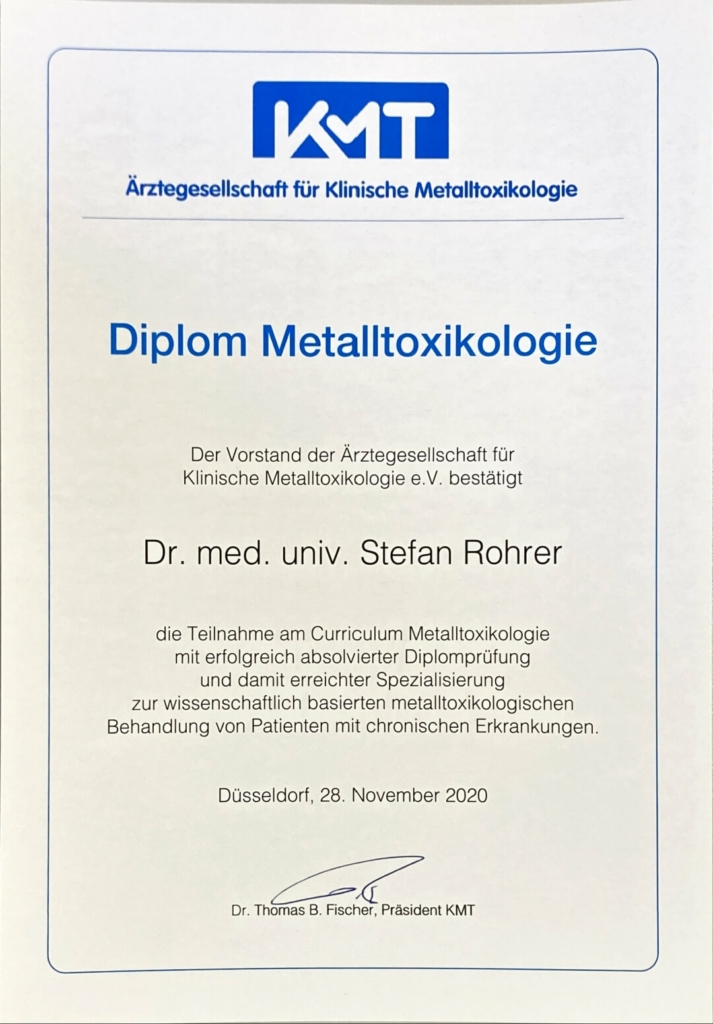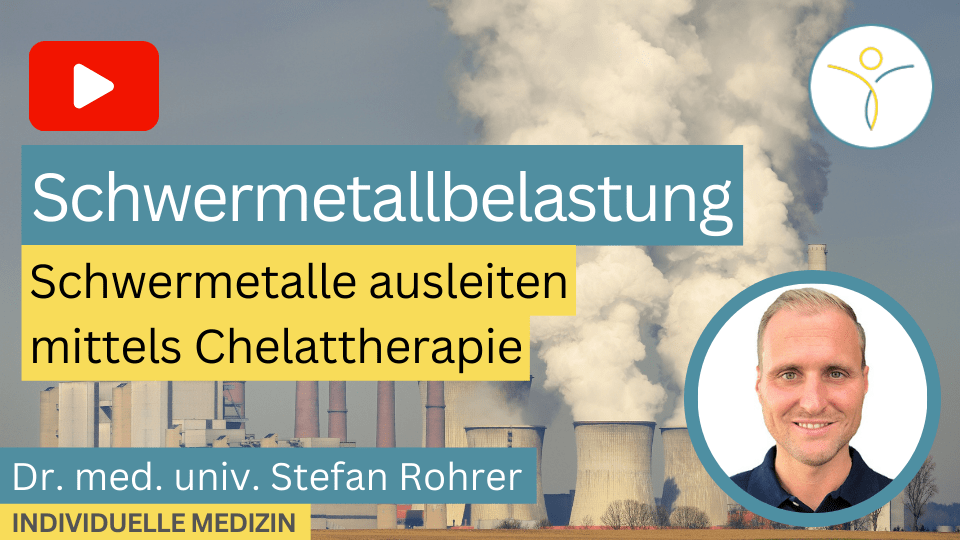Heavy metal detoxification with chelation therapy
More and more attention is being paid to the importance of metals as a potential (co-)cause of disease. Even low-level exposure to heavy metals such as lead, cadmium and mercury over a long period of time can increase the risk of diseases such as heart attacks, cancer, high blood pressure, autoimmune diseases, diabetes and neurological disorders, depending on individual genetics and other concurrent causes.

Chelation therapy is a method that has been used worldwide for over 60 years to bind heavy metals in the body in order to remove them from the body. In the following you will receive comprehensive information about the effects of metal exposure, diagnostic possibilities and the use of chelation therapy to remove them from the body. The removal of metals (especially cadmium removal, mercury removal, lead removal and aluminium removal) is becoming increasingly important in view of the increasing environmental pollution and the demonstrable increase in the concentration of metals in the air, the soil and even in our food chain. It should be added that the use of amalgam as a dental filling material over the last few decades has also resulted in a significant exposure to metals (amalgam is a metal alloy containing mercury).
Background information: Heavy metal pollution
Heavy metal exposure (and light metal exposure, aluminium is a light metal) can be one of many causes for the development of chronic diseases of all kinds.
In orthodox medicine (unfortunately) only acute heavy metal poisoning, for example by lead or mercury, plays a recognised role as a cause of health complaints. Chronic, low-dose, long-term exposures to metals are not recognised as a relevant cause of chronic diseases.
However, heavy metals are usually accumulation poisons, which means that they accumulate in the body over a long period of time and are only excreted very, very slowly, e.g. with regard to lead, mercury and cadmium. The half-life of mercury, for example, is between 18-28 years, and the half-life of lead is greater than 20 years. Therefore, it is clear that only above certain concentrations do complaints occur in the respective individual and exposure to low concentrations of toxic metals can of course contribute to health problems.
Therefore, it is incomprehensible to me personally that chronic low-dose metal exposures are not held as a cause or partly responsible for the development of chronic diseases and that this has to be discussed at all.
Additional individual factors:
Many people also have alterations in their detoxification genetics (so-called SNPs). Here especially in phase 1 and phase 2 of liver detoxification, which are essential for the metabolisation of foreign substances and environmental toxins (xenobiotics) and their removal from the body.
As an example, 50% of the Central European population have a functional complete loss of GST-M1 (= GST-M1 deletion). This leads to a reduced activity of phase 2 of liver detoxification and thus contributes to an increased accumulation of environmental toxins through a reduced excretion of these, as well as the accumulation of heavy metals, and their negative consequences.
Video: Heavy metal contamination / eliminating heavy metals
Symptoms of heavy metal exposure / effects of (chronic) metal exposure
Toxic metals that accumulate in the body over years can also displace minerals (e.g. zinc, selenium, iron, etc.) from their binding sites in the body (Lin et al., J Toxicol Environ Health A. 2013; Krone and Harms, J NCI 2003). One example is the displacement of iron by aluminium from enzymes of ATP synthesis (Han et al., Cell Biol Toxicol 2013). This leads to a reduced supply of energy (ATP=energy), and can lead to a variety of disorders.
Another example is the competition for the incorporation of cadmium or zinc into DNA repair enzymes (Lin et al., J Toxicol Environ Health A. 2013; Krone and Harms, J NCI 2003). In the latter, the incorporation of cadmium into these enzymes leads to DNA repair no longer being carried out properly, and the disturbed DNA repair can lead to the development of mutations and, in the course of time, possibly also to cancer. Likewise, competition arises at transporters of the blood-brain barrier between toxic metals and minerals (e.g. at the DMT-1 receptor, van den Heuvel, PZ 13/2012). Here it can happen that metals, because they are in higher concentrations at the transporter, then pass into the brain instead of the minerals.
In summary, it can be said that a good supply of the important minerals, for example zinc, copper, selenium and others, is important and a deficiency of these should certainly be compensated. A high normal concentration of these minerals can have a positive effect in the case of chronic exposure to toxic metals. However, it should also be noted that the minerals compete with each other, e.g. for absorption and binding sites, and an over-supplementation with minerals or with individual minerals must also be avoided. This must be checked by laboratory chemistry.
Chronic metal exposure can also contribute to the development of oxidative stress (OS). This, in turn, can contribute to the development of chronic diseases of all kinds (e.g. atopic diseases: neurodermatitis, allergies etc. or autoimmune diseases) and also to cardiovascular diseases and arteriosclerosis.
Likewise, there is often a toxic effect on mitochondria, the power plants of the cell, and an activation of the immune system resulting in chronic inflammation (“silent inflammation”). Likewise, a connection between chronic metal exposure and the development of neurodegenerative diseases is being discussed, especially in the field of functional medicine and complementary medicine, although there is certainly still a great need for research here and solid studies are lacking (as far as I know).
Furthermore, metals can trigger a so-called type-4 allergy in the body (e.g. gold, nickel). This is diagnosed by means of an LTT test (blood test) in addition to the direct test procedures on the skin. A type 4 allergy can also lead to a variety of symptoms, such as chronic fatigue and tiredness, rashes, urticaria, joint pain and other problems.
How do heavy metals and aluminium enter the body?
Metals enter our bodies through different pathways. For example, through food, through the air and through medications. Fine dust contains e.g. mercury, lead, cadmium and nickel. In the following, mercury will be discussed in particular.
Human activity has doubled mercury concentrations in the top 100m of the oceans in the last 100 years (International agreement on mercury reduction 19 January 2013). Mercury accumulates in the food chain. Depending on the dose, mercury can damage the nervous system, the immune system and sometimes also causes cardiovascular diseases (as does lead).
Mercury is absorbed through food, for example. Here, the consumption of sea fish is particularly noteworthy. Tuna, for example, is heavily polluted.
However, the release from industry as well as from doctors’ practices is also very substantial. “Between 60 and 90 tonnes of mercury are released from dental practices every year, contaminating Europe’s atmosphere, surface water and soil (MEP Jean Huss, Luxembourg’s representative to the Council of Europe Report on amalgam as a dental filling material, May 2011)”.
With the continued expansion of coal-fired power plants in China, coal combustion will become the largest emitter of mercury in the future (David G. Streets, Qiang Zhang and Ye Wu: Projections of Global Mercury Emissions in 2050. Environ. Sci. Technol., 2009, 43 (8), pp. 2983-2988; doi:10.1021/es802474j).
And Germany is not without its own either. German coal-fired power plants emit an estimated 5 tonnes of mercury into the atmosphere per year (source: Federal Environment Agency).

Heavy metal exposure - diagnostic options
We carry out complete blood analyses in our practice. Here we determine the minerals and also the most important toxic metals.
We also carry out metal excretion tests (formerly called provocation tests, currently CEMET = chelated metal excretion test). Here, so-called chelates are administered. These are binding agents which are approved in the field of orthodox medicine for acute heavy metal contamination. For example, DMPS is approved for acute mercury poisoning. We carry out a so-called off-label therapy here, i.e. we use DMPS beyond its approval after appropriate clarification. This must be pointed out because chronic metal contamination is not recognised by orthodox medicine, so it is a so-called “off-label use”.
Further information can also be found on the wensite of the Society for Clinical Metal Toxicology (=KMT): https://www.metallausleitung.de/
As part of the test, chelates are administered. 1 hour later, the patient submits a urine sample, which is analysed for the concentrations of various minerals and metals. The examination is carried out at the laboratory IMD Berlin. After the examination, an assessment is made in conjunction with the medical history and your previous findings and symptoms as to whether chelation therapy is appropriate for your case.
Removing heavy metals through chelation therapy

In our practice, we perform chelation therapies with DMPS, DMSA, EDTA, and DTPA.
Depending on the chelate used, different metals can be bound or eliminated to different degrees. DMPS has a very high affinity to mercury and also to aluminium, but also binds lead and cadmium more weakly, for example. It is mainly used for mercury elimination and also aluminium elimination or chelation (binding).
Calcium sodium EDTA binds mainly lead, but also cadmium to a lesser extent. We use it mainly for lead elimination, cadmium elimination and in the context of circulatory disorders (but then over an infusion period of at least 3 hours). Mercury is not bound by this chelator.
We use zinc trisodium pentetate (Zn-DTPA) in patients with suspected gadolinium exposure or gadolinium deposition disease (GDD) for gadolinium elimination. It is suspected that GDD can occur if patients have had multiple MRIs with contrast media containing gadolinium.
The chelators bind free metals in the bloodstream and kidney and then form water-soluble complexes which are excreted via the kidney.
Chelation therapy can also be accompanied by side effects, it is not always pleasant for patients. We will be happy to advise you on this and you can rely on our advice here.
Supportive measures are always useful for so-called “bad detoxifiers”. This refers to people who have, among other things, many SNPs (single nucleotide polymorphisms) in phase 1 and 2 of liver detoxification or genes that code for detoxification enzymes.
Poor detoxifiers are mostly characterised by a too fast phase 1 (cytochrome P 450 enzymes – 39 CYP enzymes are known), which leads to an increased accumulation of highly toxic intermediates, and a too slow phase 2 of liver detoxification (enzymes: GSTM1, GSTT1, GSTP1, SOD1, SOD2, NAT), which then can only metabolise and excrete the highly toxic intermediates slowly.
The ability to detoxify is (unfortunately) largely genetically determined. Therefore, if the enzyme system is missing or has limited functionality, the body’s own detoxification cannot take place sufficiently. Poor detoxification capacity is also associated with an increased rate of cancer, among other things. If desired, we can analyse the detoxification genetics and advise you individually on this.
Furthermore, gentler methods to support detoxification, for example by infusion with alpha lipoic acid, glutathione or phosphatitylcholine and other active substances can be carried out, and/or chelation therapy can be supplemented by them.
If you have any further questions about the heavy metals detoxification, or chelation therapy, or if we have aroused your interest, please feel free to contact us at any time and we will answer your questions in detail.
Dr. med. univ. Stefan Rohrer is a certified doctor with a metal toxicology diploma.


